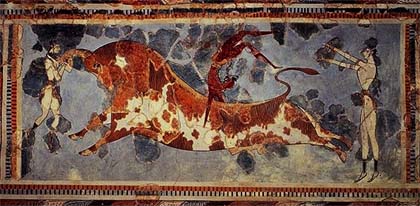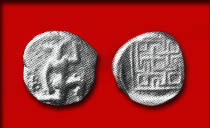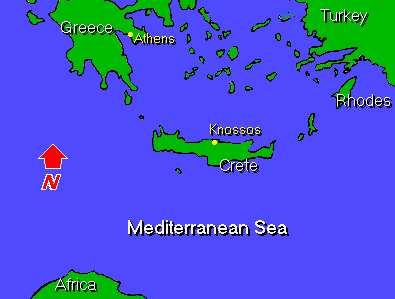According to ancient greek myths, the great greek
King Aegeus was forced to pay tribute to King Minos of the Minoans,
whose kingdom was on the island we now call Crete. Every year
the tribute included seven young men and seven young maidens.
Underground far below King Minos' palace at the city of Knossos
lay a huge maze built for him by the
inventor and master architect Daedalus. Inside the maze Minos
kept a monster called the Minotaur. The Minotaur was a hideous
creature that was half man and half bull. The fourteen young
people from Greece would be let loose into the maze, the labyrinth,
where they would become hopelessly lost and eventually be eaten
by the Minotaur.
According to the legend, King Aegeus' son, Thesesus,
decided to volunteer as one of the sacrificial victims, so that
he could attempt to kill the Minotaur. Thesesus was successful.
He slew the Minotaur, then used a trail of twine he'd started
laying down at the entrance of the labyrinth to find his way
out of the maze.
So how much of this incredible tale is based on
reality? Ancient writers from Roman times argued that the Labyrinth
was a set of winding caves they knew were located on the south
side of Crete at Gortyna. In the early 19th century C.R. Cockerell
visited these caves and wrote in his journal that he and his
party entered the cavern through an inconspicuous hole in the
hillside of Mount Ida and unwound a length of twine to keep
from getting lost. "The windings," wrote Cockerell,
"bewildered us at once, and , my compass being broken,
I was quite ignorant as to where I was. The clearly intentional
intricacy and apparently endless number of galleries impressed
me with a sense of horror and fascination I cannot describe.
At every ten steps one was arrested, and had to turn to right
or left, sometimes to choose one of three or four roads. What
if one should lose the clue!"
|

A
sketch of the Gortyna cavern as seen in the 19th century.
|
The caves at Gortyna, as much as they might
seem to fit the legend are in the wrong place as the Labyrinth
was supposedly located at Knossos. Some writers have speculated
that another similar set of caves, now lost, near Knossos
served as the Labyrinth, but modern archaeologists have come
to another conclusion.
Archaeologists have found no evidence that a
horrible half-man, half-bull-like creature existed at Knossos.
However, they have found what looks like a labyrinth. The
labyrinth wasn't built in a cave below the palace, though.
It was the palace.
The Minoans are a mysterious people. We do not
know where they came from, but they seemed to have arrived
in Crete about 7000 BC. By all indications the Greeks feared
the Minoans, but the Minoans did not seem like a warlike people
(their cities had few fortifications). Little is known about
the Minoan's religion or their form of government. We cannot
read the writing they left behind. In fact, researchers have
been unable to figure out even by what name the Minoans called
themselves. The term Minoan comes from the legend of King
Minos and was coined by archaeologists because they needed
a term to describe their discoveries at Knossos.
|

A
fresco from the Minoan palace at Knossos showing the
sport of "bull leaping."
|
If the Minoans had power it must have come from
trade, not war. They exchanged goods with peoples from all
around the eastern Mediterranean. Ostrich plumes came from
northern Africa, alabaster from Egypt, gold and silver from
the Aegean Islands and ivory from Syria. They alll passed
through Minoan hands, making Mionan profits, on their way
to distant destinations.
The wealth from the trade financed a number
of palaces on Crete, the largest of which was the palace at
Knossos. Archaeologists are not exactly sure who lived in
the Knossos palace. However, they have uncovered a quantity
of ceremonial and religious imagery there. This leads some
to believe that the chief occupant of the building was a 'priest-king'
who had the dual function of leading the state and the religion.
Other scholars see the palace as a only a temple. Others as
a center for trade.
Whatever the palace's function, the building
itself was enormous. It contained hundreds of rooms at many
levels grouped around a central courtyard. The palace had
storerooms, bathrooms, private apartments, public rooms, workshops
and even what appears to be a throne room. Some of the storerooms
contained dozens of huge jars, called pithoi, which
were used to contain olive oil. According to some estimates
60,000 gallons of olive oil could be put in these, which is
a testament to the Minoan's wealth.
|

This
siliver coin from Knossos dated at around 500 B.C. shows
the Minotaur on one side and the Labyrinth on the other.
|
While there is no archaeological evidence of
a labyrinth, the palace itself to a visitor must have seemed
like an intimidating maze of corridors, staircases and rooms.
This is probably where the legend of the labyrinth began.
An early version of the palace was started around 1900 BC,
but was demolished for a grander one in 1700 BC. Unlike the
Greeks, the Minoans did not consider symmetry an important
attribute of architecture. Rooms and halls seem to be added
almost at random, though they were undoubtedly placed with
a practical purpose in mind. The lack of symmetry does not
mean the palace was ugly. Each room had its own beauty and
many were decorated with frescoes. The palace reflected the
Mnoans practicality. Much of the structure and columns were
made of wood, which was more likely to survive an earthquake
than stone. The palace had a sanitary drainage system to take
wastewater away from the apartments. The drainage channel
was even designed with zigzags and basins to slow down the
water to prevent overflows. Many of the rooms are partly underground
to keep them cool in the summer and warm in the winter. Colonnaded
porches allow cool breezes in, but kept out the hot sun.
If the palace is the origin of the labyrinth
myth, where did the legend of the Minotaur come from? We know
that the Minoans had a fascination for bulls. Their most mysterious
art shows human figures, some of them girls, grabbing the
horns of a bull and leaping over it. Archaeologists have wondered
if this strange and dangerous activity really did take place.
If it did, was it merely a sport, or did it have some religious
significance? Recent archaeological excavations have shown
an arena-like structure outside one of the Minoan palaces
that might have been the site of these mysterious activities.
Whatever the significance of the bull-leaping, it was probably
the genesis of the Minotaur myth.
Why bulls? Crete is subject to earthquakes.
Perhaps the violent and unpredictable movements of the earth
seemed to them like the temperamental acts of a creature such
as a bull. The Greek god Poseidon was known as the 'earth-shaker'
and was connected to bulls, so perhaps the Minoans were worshiping
an earlier form of this god in their ceremonies.
 Archaeologists
think that the end of the Minoan culture came about 1450 BC.
Seventy miles away, a volcano exploded on the island of Thera.
This caused a huge tidal wave to hit Crete which destroyed
many major buildings and probably their fleet of ships. The
wave ended the Minoan's ability to conduct trade, causing
them to quickly lose power in the eastern Mediterranean.
Archaeologists
think that the end of the Minoan culture came about 1450 BC.
Seventy miles away, a volcano exploded on the island of Thera.
This caused a huge tidal wave to hit Crete which destroyed
many major buildings and probably their fleet of ships. The
wave ended the Minoan's ability to conduct trade, causing
them to quickly lose power in the eastern Mediterranean.
Some scholars suggest that the end of the Minoan
culture may have inspired stories about the continent of Atlantis.
The story of the destruction of a powerful and sophisticated
culture by water in one night seems extremely similar, though
the dates and location must have been exaggerated over time.

Copyright Lee Krystek
2001. All Rights Reserved.